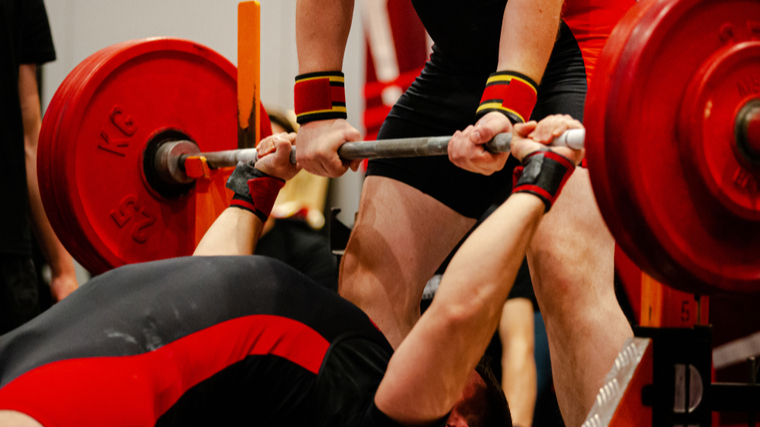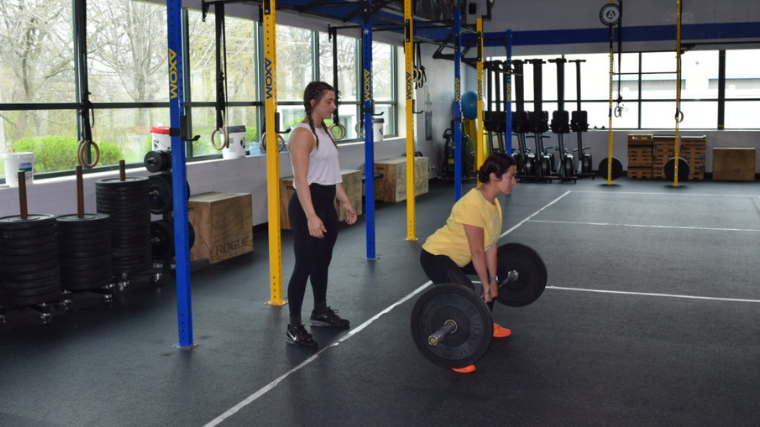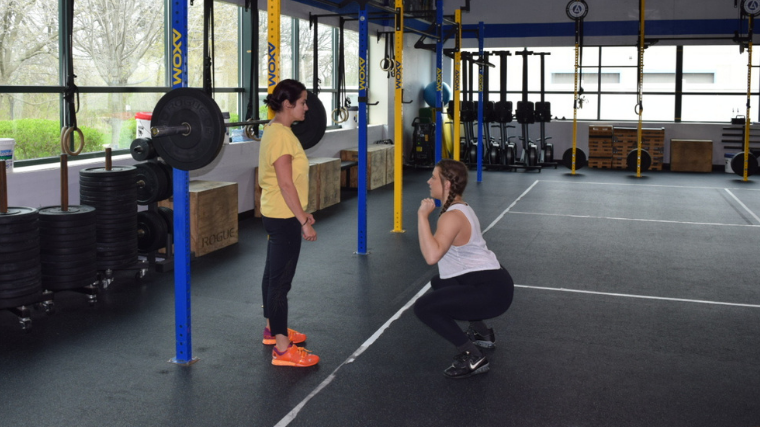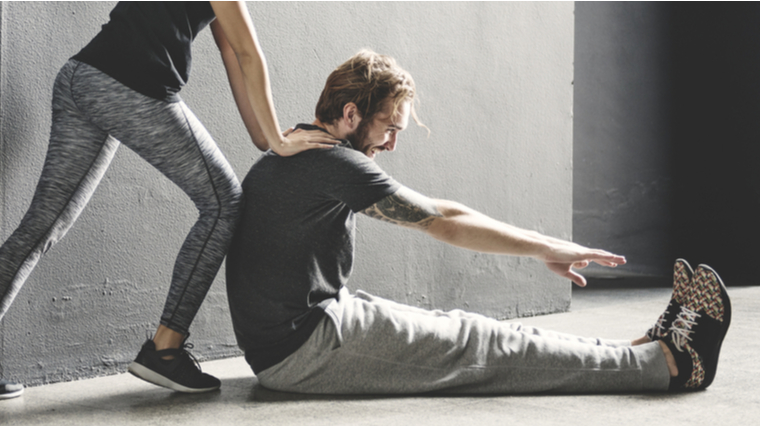Picture this. You’re on week three or four of your new gym routine, humbly grinding through one of your workouts in the weight room when one of the locals approaches you out of the blue with a proposition:
Even if you’ve been lifting weights for a while, that prospect might still inspire terror as your new friend, the 220-pound-plus powerlifter, confidently sets up for his set on the bench press with a weight you could only dream of lifting. He’s placed his safety in your hands — so what do you do?

A good spotter can make the difference between hitting a new personal record or not when you go to test your strength. For bodybuilders, spotting is a way of helping your training partner realize their full potential for as much muscle growth as possible.
Spotting is an art, and you shouldn’t paint with broad strokes if someone asks you for help. Here’s how to get it right, and why it matters.
The Ultimate Guide to Proper Spotting
- What Is Spotting?
- What Are the Goals of Spotting?
- How to Spot Properly
- Benefits of Spotting
- Lifts You Don’t Need to Spot
What Is Spotting?
You can think of a spotter as your shepherd in the weight room. Spotting is the practice of observing, guiding, and, if necessary, saving an errant lift that may pose a physical danger to the athlete.
Spotters are used in recreational bodybuilding workouts and at powerlifting meets alike. Anytime you’re working with ultra-heavy weights, you may want to have a spotter present to help you out of a bind should things go wrong.
Alternatively, a good spotter can also encourage you to work harder during your set by providing you with the security and stability to train to failure safely. This allows you to get as much juice as possible out of every rep, meaning more muscle growth long-term.
What Are the Goals of Spotting?
As an athlete, you have one goal — lift the weight. As a spotter, your job is a little more complex. Not only do you have to ensure that the person you’re spotting remains safe and in control, but you can go the extra mile to help them perform a bit better as well.
Goal 1 — Secure the Setup
Some exercises (like heavy dumbbell work, for instance) can be cumbersome to set up, even if the lifter is strong enough to hit all their reps. Getting into position on the bench press, for example, can make or break the lift itself.
Any spotter worth their salt knows to help the athlete set up properly to execute whatever movement they’re performing. Moreover, as a spotter, you can help them save as much energy as possible by doing much of the setup legwork yourself.
Goal 2 — Guide the Path
Once you’ve helped your athlete set up for their lift, your next task is to do nothing. Much like a lifeguard, you’re not stationed at your post to help people with their backstroke, only to intervene if things go awry.
Many strength athletes regard uninvited assistance as the cardinal sin of spotting. Once they’re good to go, let them lift.
However, you should be ready at a moment’s notice to spring into action if needed. As such, you should keep your hands at the ready, out of the path of the weight they’re lifting but close enough to catch a falling barbell or assist with a squat that’s moving in the wrong direction.
Goal 3 — Spring Into Action
You shouldn’t expect it to happen, but you must be ready if it does. In the event the athlete is in peril, or outright signals to you that they need help, you must leap to their aid as fast as possible to ensure they get out of the lift — and harm’s way.
Goal 4 — Listen
Synergy is what separates a mediocre spotter from an excellent one. Your job is to make everything but the lift itself feel effortless for the athlete you’re working with. It is therefore essential to listen to their preferences.
Some lifters want a helping hand getting their bench press into place, some don’t. Others want a bit of an assist if their bar speed slows down, while others still are very adamant that you shouldn’t lay a finger on their bar unless it is visibly moving in the wrong direction.
The most important thing you can do is ask questions. If you’re going to spot someone, ask them how they like it. You should have a game plan in place once they’ve begun lifting.
How to Spot Properly
The best spotters can make maximum effort lifts feel effortless. Here are the lifts that matter as a spotter, and how to set the lifter up for success every time.
Back Squat
The back squat is unparalleled for building serious leg strength. However, especially for low-bar squatters, it can be a bit dicey to get pinned under a heavy squat with no way out. A good spotter can help the athlete finish their squat safely — you’ll just have to get up close and personal.
How to Spot the Back Squat

[Read More: Powerbuilding Workout Routine, With Tips from a CPT]
Stand several feet behind the lifter as they unrack their barbell and step backward into place. Once they’ve secured their footing, step forward so you’re slightly behind them and your footing mirrors theirs.
As they descend, crouch with them with your arms hovering outside their torso. If they hit a sticking point, ask you for help, or the bar begins traveling downward, grab their trunk with your arms and help them stand up.
Note: Squats aren’t always practical to spot. If your lifter hits the bottom of their range of motion and can’t stand up at all, it’s best to have them dump the bar manually than attempt to pick them up out of the hole yourself.
Deadlift
You don’t usually need to spot pulling movements. There’s no practical way to help someone pick up a max-effort deadlift. That said, athletes do get a bit lightheaded from time to time, especially when trying to pull extra-heavy weights. Your job is to be there to catch them if they fall.
How to Spot the Deadlift

Stand one or two feet behind the athlete as they set up for their pull. Once they begin pulling, take a slight step forward with your arms at the ready. If they stumble or fall backward from dizziness, reach out and help them catch their balance.
Dumbbell Bench Press
Dumbbells are great for muscular symmetry, proportion, and hypertrophy. That said, they can be awkward to work with on movements like the bench press. Heavy dumbbells can almost have a mind of their own, so as the spotter you need to help your athlete get them where they need to be.
How to Spot the Dumbbell Bench Press

Stand or kneel behind the back end of the bench as the athlete grabs the dumbbells. As they sit back onto the bench, grab their elbows with your palms and help them push the weights to arm’s length.
From here, keep your hands just underneath their elbows as they lower and press the dumbbells. If they request assistance, push up on their elbows with your arms. If they want to dump the weights, move your hands out of the way so the athlete can drop the dumbbells to the floor.
Barbell Bench Press
Few lifts are dependent on a good spot as much as the barbell bench press. If you get your technique just right, you can legitimately help the athlete add pounds to their personal record with a proper spot.
How to Spot the Barbell Bench Press

Stand clear of the station as the athlete goes through their setup ritual. Once they’ve signaled that they’re ready to lift, approach the station. Do not stand directly over their head. Lean forward and grab the middle of the barbell.
On their signal, help them pull the bar horizontally out of the hooks. Do not pull the bar upward, as it may release their shoulder brace.
Once you’ve guided the barbell into the starting position, release your grip on the bar but hover your hands a few inches away from it at all times. If the lifter signals that they need assistance, grab the bar and pull it back into the rack.
Dumbbell (or Barbell) Shoulder Press
Big presses make for strong shoulders, but getting heavy dumbbells into the proper starting position can be both challenging and draining for the athlete. You can help them save energy as a spotter by guiding the weights into the correct position.
How to Spot the Shoulder Press
If the athlete is working with dumbbells, stand behind the seat. When they go to “kick” the dumbbells up with their knees, clasp their elbows in your palms as fast as possible and push their arms upward until they’re straight.
From here, follow the same protocol as you would while spotting a dumbbell bench press — follow their elbow path with your hands, but do not provide assistance unless asked.
If the athlete is pressing with a barbell, you can stand behind them and help push their elbows up if they ask or, in a worst-case scenario, catch them should they fall backward with the bar.
Benefits of Spotting
A good spotter can inspire confidence, increase safety, and help an athlete work harder in the gym. Though no one needs a spotter in all cases, you’d do well to consider having (or being) one for many types of heavy training.
Easier Setup for Heavy Lifts
Even world-class athletes with incredible levels of strength can have trouble getting their barbells into the right position. After all, a heavy set of dumbbell presses doesn’t begin until the weights are at arm’s length. There’s no shame in having a spotter help you out with the setup so you can focus on perfect form on every rep.
More Safety
Far and away the best reason to have a spotter present is safety. Working with free weights comes with tremendous benefits, but there is always a risk factor present to some degree.
A good spotter won’t guarantee complete safety in every single situation, but they will be able to help you out of a bind most of the time and spare you from a potentially-injurious situation that may arise from losing control of a heavy weight.
Improved Confidence
It may not be obvious, but having a spotter can do a lot for an athlete’s confidence. Knowing that you have someone watching your back (literally) should help you feel more conviction when you go to unrack your barbell or kick up those dumbbells.

A spotter is more than a safety net, they’re also a source of motivation. Even a little bit of healthy anxiety, or a desire to want to do well while you’re being watched, can help you perform better during your set.
Higher Training Intensity
A spotter has more than one job. Preventing accidents and mitigating risk is one thing, but as a spotter, you can also help your athlete or training partner put in more effort.
A good spotter can take an active role and help the lifter crank out a few extra reps or push themselves to the brink of failure in a way they wouldn’t be able to do alone. Forced reps and hearty verbal encouragement can go a long way in the right context if your goal is muscle growth.
Lifts You Don’t Need to Spot
While you technically could spot any lift under the sun, sometimes there’s simply no need, no reason, or no sensible way to do so. Here are some of the cases in which you shouldn’t need to come to the rescue.
The Olympic Lifts
In the sport of weightlifting, athletes compete solo on the competition platform. Unlike in powerlifting, which occurs under controlled conditions with multiple spotters, weightlifters learn from an early training age to “bail” out from underneath heavy barbells that are flying in the wrong direction.
Moreover, it’s simply not practical to spot someone while they perform a clean, snatch, or jerk. There’s too much dynamic movement at play for you to make a meaningful impact most of the time.
Pulls
Pulling movements are essential for developing a strong and muscular back. From rows, to deadlifts, to pull-ups, every posterior chain exercise you can possibly think of is a valid tool for gaining size. Fortunately, you don’t need to spot someone on most pulling movements.
The physical nature of the movement — drawing a weight toward your body rather than pushing it away — means that a lifter can abandon a bad pulling exercise safely simply by letting go of the weight. Most of the time, there’s no good way to protect someone on a set of dumbbell rows in a fashion they can’t do themselves.
Calisthenics
Since there’s no external resistance, the risk of something going wrong on a bodyweight exercise is relatively low, even for beginners. That said, advanced calisthenics exercises can be difficult to get the hang of on your own — something gymnasts are plenty familiar with.

You may not need to spot a bodyweight exercise in the traditional sense, but you can be present to manually adjust the athlete’s posture if they can’t quite figure out the form on their own.
Spot the Difference
What may have been an intimidating experience — “helping” a stronger, more experienced lifter perform a heavy set on the bench press — was probably more of a relief for that person than you realized at the time.
As a spotter, you bring peace of mind, security of movement, and heaps of inspiration to anyone you’re working with. Good spotting is a skill, one that you can hone and practice in the gym over time.
Not only will it help you feel more confident in your own lifting, but you can also improve your training partner’s own workouts the same way they do for you. Get good at spotting — it’s the closest you’ll come to being a superhero in your gym.
Featured Image: Riley Stefan
